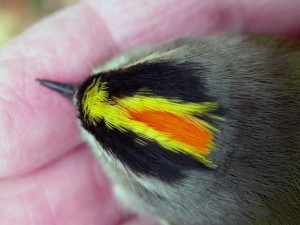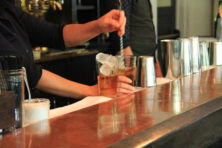The Golden-crowned Kinglet
- Share
- Tweet
- Pin
- Share

The Ruby-crowned Kinglet which lived in Lukes’ front yard for a month in early 2007.
It happened on Wednesday the 27th of this past October on one of the incredibly stormy and windy days. I was walking back to the house from the mailbox when I came across a Black-capped Chickadee and a Golden-crowned Kinglet foraging for food in the small Sugar Maple and Ironwood saplings right next to the driveway. Both birds, with the Kinglet no more than seven or eight feet above my head, clung with all their might as the violent wind whipped them back and forth during their food-finding.
My guess is that a person would have to use a hand lens in order to see what those hardy creatures were eating, perhaps mites, aphids or aphid eggs. How else could you accurately know what those birds were eating without actually killing one and inspecting the contents of its stomach? It’s somewhat easier in studying larger birds to actually observe them as they feed, but these tiny kinglets don’t offer you a single clue as to what they are finding on the twigs and branches. What makes it doubly difficult in observing them is that they are constantly on the move, the Kinglet even more so than the Chickadee.
The best Golden-crowned Kinglet observations in Door County I’m aware of, made during the 1970s, including the proof and location of their nesting high in some White Spruces at the Ridges Sanctuary when I worked there, was done by a very skilled student of birds from UW-Stevens Point, Kevin Glueckert. What helped him initially locate the Kinglets along the Spruce Trail fairly close to the nature center was his uncanny and impeccable hearing. Their call notes consist only of extremely high, thin tsee notes, which many people can’t hear.
This is precisely what enabled us to locate wintering Golden-crowned Kinglets during several annual Christmas bird counts at the Toft Point State Natural Area. It was during some of those winters that I observed, while snowshoeing at the point, these Kinglets along with Black-capped Chickadees, Red-breasted Nuthatches and Brown Creepers busily foraging together for food, often upon the dried stems of thimbleberry canes fairly close to the ground. It boggles the mind realizing that these Kinglets, weighing less than a quarter of an ounce and being between three and a half to four inches long, are not only withstanding winter daytime temperatures of down to -30º F but also spending nights as long as 16 hours without food – and surviving!
I am now reading an outstanding book, Winter World, the Ingenuity of Animal Survival, written by Bernd Heinrich, professor of biology at the University of Vermont. He is also the author of Mind of the Raven, which I also highly recommend. For several years he had been trying to learn what food helped sustain the Golden-crowned Kinglets in the intense cold of winter near his cabin in northern Maine, virtually defying the odds and laws of physics in being able to do so. This reminds me of studies of Bumblebees done by flight engineers who determined that theoretically the Bumblebees were incapable of flight!
Heinrich found that the Kinglets had to sustain a body temperature of 110º F in order to survive the winter. It can’t be without food for more than one to two hours during its very short winter day of around eight hours, yet by puffing its feathers outward, goes without food during about 16 hours of darkness and manages to survive. Their tiny body is virtually hidden inside around a two-inch-thick small ball of feathers. Another fact to be considered is that the colder the day the more Kinglet energy must be spent keeping warm.
Following several winters of failure in locating the primary food of the Kinglets Heinrich was studying, the mystery was finally broken. He simply had to obtain the proper federal and state permits that allowed him to kill several of the kinglets in order to study their stomach contents. To his surprise he learned that the Kinglets were consuming frozen, yet still alive caterpillars of Geometrid (gee-o-MET-rid) moths. These caterpillars are the more familiar so-called “inch worms.” Of the dozens of species of Geometrid moths, the only one they were able to accurately identify was that of the One-spotted Variant.
Every Golden-crowned Kinglet I handled and banded during my 25 years of bird-banding left me in awe at how this tiny but mighty creature, next smallest bird in the Midwest to the Ruby-throated Hummingbird, can survive in an area year-around while enduring air temperatures ranging from -30º F to 90º F. Heinrich made the plea in his Winter World book that in order to care for the winter survival and welfare of Kinglets, it is necessary, absolutely vital, that we also care for moths.
Charlotte and I had an endearing experience at our home being able to observe a male Ruby-crowned Kinglet, close relative of the Golden-crowned Kinglet, in our front yard and surrounding woods on a daily basis between Jan. 7 and Feb. 4, 2007. This tiny bird rarely winters in the north in the state. According to Sam Robbin’s wonderful book, Wisconsin Birdlife, these Kinglets have nearly all left the northern part of the state by October 20, while only a few stragglers remain in the southern region after November 10.

A Golden-crowned Kinglet in Roy’s hand being banded.
Ruby-crowned Kinglets and Golden-crowned Kinglets are not considered to be seedeaters. We were surprised to watch the wintering Ruby-crowned Kinglet visiting our marvel meal feeder many times during the day and, in a sense, feasting on ground-up seeds, including peanuts. Surely this highly nutritious food was serving the kinglet only as a supplement to its usual insect diet.
The nighttime temperature on the final day, Feb. 4, 2007, of our Kinglet’s winter visit plunged to -14º F and that was the last day we saw and enjoyed it. Its stay with us considerably increased our overall respect and admiration for the Kinglets. In our hearts we crowned the two ‘little kings’ “the greatest!”



